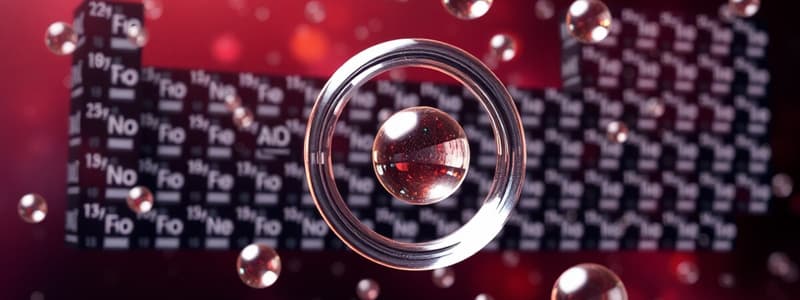Podcast
Questions and Answers
What distinguishes one element from another?
What distinguishes one element from another?
Which statement accurately describes the Periodic Table?
Which statement accurately describes the Periodic Table?
What is the atomic number of hydrogen and why is it significant?
What is the atomic number of hydrogen and why is it significant?
Which of the following is a characteristic of metals?
Which of the following is a characteristic of metals?
Signup and view all the answers
How many natural elements are known to scientists?
How many natural elements are known to scientists?
Signup and view all the answers
What role do subatomic particles play in distinguishing elements?
What role do subatomic particles play in distinguishing elements?
Signup and view all the answers
Which element is the lightest and most abundant in the universe?
Which element is the lightest and most abundant in the universe?
Signup and view all the answers
What is the definition of an element?
What is the definition of an element?
Signup and view all the answers
What distinguishes elements from compounds?
What distinguishes elements from compounds?
Signup and view all the answers
What particles are found in the nucleus of an atom?
What particles are found in the nucleus of an atom?
Signup and view all the answers
Which statement about electrons is correct?
Which statement about electrons is correct?
Signup and view all the answers
What elements make up water?
What elements make up water?
Signup and view all the answers
In a stable element, what is true about the number of protons and electrons?
In a stable element, what is true about the number of protons and electrons?
Signup and view all the answers
Why are hydrogen and oxygen considered elements?
Why are hydrogen and oxygen considered elements?
Signup and view all the answers
Which of the following statements about matter is correct?
Which of the following statements about matter is correct?
Signup and view all the answers
Study Notes
Elements
- Elements are pure substances made of only one type of atom.
- Elements cannot be broken down into simpler substances.
- Elements are the building blocks of all matter.
- Elements can combine to form compounds and mixtures.
What Elements Are Made Of
- Elements are made of tiny units called atoms.
- Atoms contain subatomic particles: protons, neutrons, and electrons.
- Protons and neutrons reside in the nucleus, the dense center of the atom.
- Electrons are in constant motion around the nucleus in the electron cloud.
What Makes Each Element Different
- Each element has a unique number of protons, called its atomic number.
- The number of protons determines the element's identity.
- The number of neutrons can vary in an element, creating isotopes.
- The number of electrons determines the element's reactivity and many of its properties.
The Periodic Table
- The periodic table organizes elements by their atomic number and properties.
- Elements in the same column (group) have similar properties.
- Elements in the same row (period) have the same number of electron shells.
Metals and Non-Metals
- Most elements are metals and have specific characteristics:
- Solid at room temperature
- Good conductors of heat and electricity
- Shiny and flexible
- Non-metals can be solid or gas and have the following characteristics:
- Poor conductors of heat and electricity
- Dull and brittle
Studying That Suits You
Use AI to generate personalized quizzes and flashcards to suit your learning preferences.
Description
This quiz explores the fundamental concepts of elements, including their composition, unique features, and the organization of the periodic table. It discusses atoms, subatomic particles, and the significance of atomic numbers in identifying elements.




